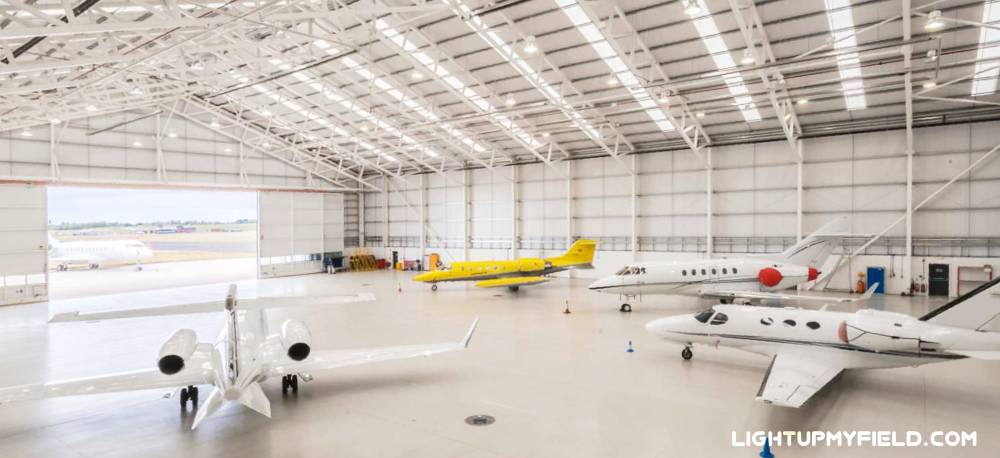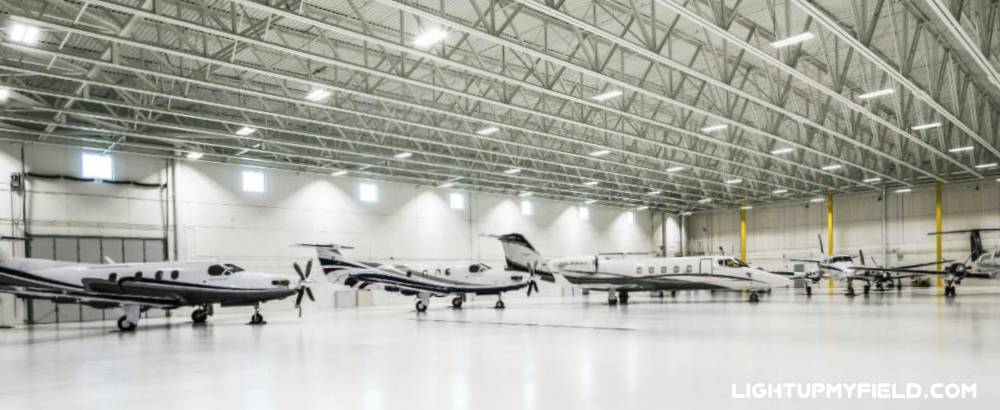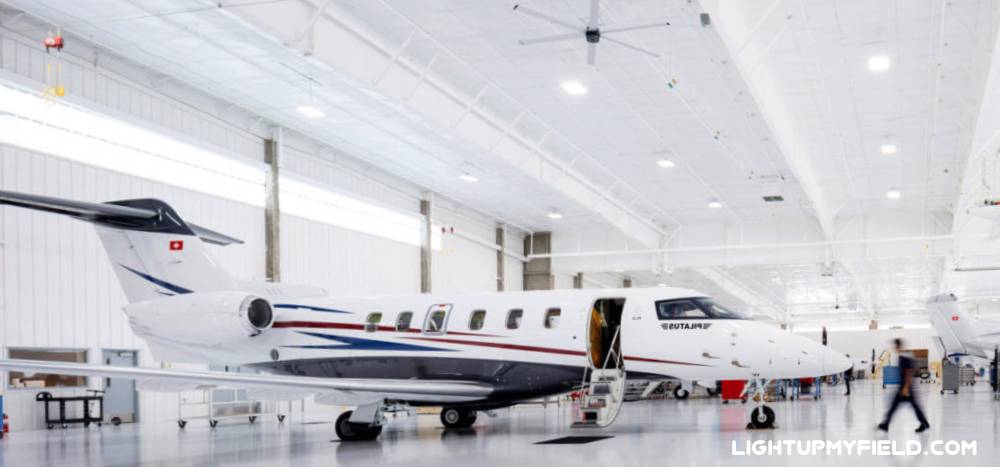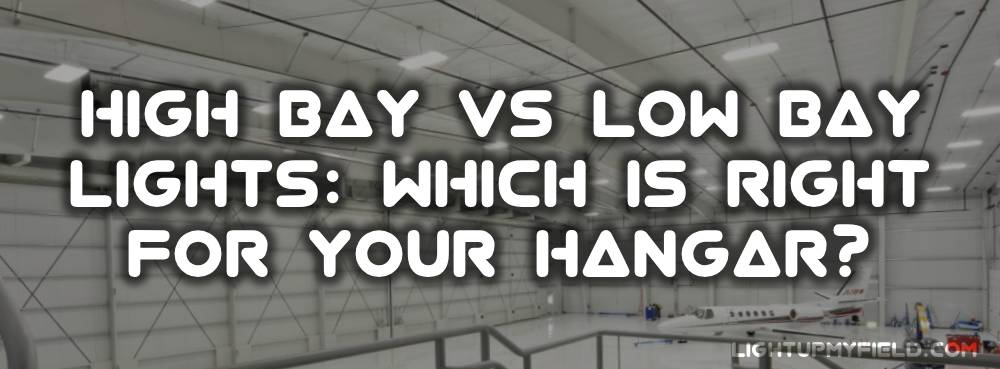Hangars are massive spaces, and the wrong lighting setup can make work harder and even less safe. Choosing between high bay and low bay lights is one of the first decisions you’ll face. Both options are designed for different ceiling heights and coverage needs, and picking the wrong one could lead to wasted energy, uneven lighting, or constant maintenance headaches.
So, what’s the real difference between these two, and how do you figure out which one is the best fit for your aircraft hangar? Let’s break it down.
Table of Contents
ToggleWhat Are High Bay and Low Bay Lights?
Before you start shopping for fixtures, it helps to really understand what high bay and low bay lights actually are. These terms mostly describe where the lights are installed and how their light is spread across a space. And trust me, the difference matters a lot when you’re dealing with something as big as an aircraft hangar.
High Bay Lighting: Built for Big, Tall Spaces

High bay lights are the heavy hitters in the lighting world. They’re specifically designed for spaces with ceilings above 20 feet, and in many hangars, that height can easily stretch to 40 or even 50 feet. At those heights, you need serious power and the right optics to make sure light actually reaches the floor evenly. Otherwise, you’ll end up with bright spots in some places and gloomy shadows in others, which is a nightmare for detailed maintenance work.
So, how bright are we talking? A single high bay LED fixture can throw out anywhere from 20,000 to 60,000 lumens, depending on the model and beam angle. For context, 60,000 lumens is like stacking 40 to 50 regular 60-watt bulbs together in one fixture—that’s the level of illumination needed to hit recommended 300-500 lux on the ground in maintenance zones.
Another key thing about high bays is how they’re mounted. Most are hung from chains or pendants, or sometimes fixed directly to the ceiling. They usually come with reflectors or lenses that focus the light downwards so you’re not wasting energy lighting the rafters. While older setups used HID lamps, LED high bays dominate now because they’re more efficient and last way longer. With LEDs pushing 130 lumens per watt or more, you get serious light without the sky-high electricity bills.
If you’re running a hangar where lights stay on for 12-16 hours a day, those savings add up fast. Imagine replacing 400-watt metal halide fixtures with 200-watt LED high bays. Across 100 fixtures, that’s a cut of 20,000 watts every hour. Over a year, that’s tens of thousands in savings just on power alone.
Low Bay Lighting: Perfect for Shorter Spaces

Now, what if your hangar isn’t a massive aircraft storage facility but more of a maintenance workshop or smaller storage bay with ceilings between 12 and 20 feet? That’s where low bay lighting comes in.
Low bay lights are designed for these lower heights because the light doesn’t need to travel as far. Using high bays in a 15-foot ceiling would create blinding glare and hotspots, which isn’t just uncomfortable but also unsafe for your crew. Instead, low bay lights provide softer, more evenly spread illumination, often using diffusers or wider beam angles to minimize harsh shadows.
In terms of output, low bays usually produce between 10,000 and 20,000 lumens, which is plenty for these ceiling heights. Just to give you a picture, a 15-foot ceiling with 15,000-lumen low bay fixtures spaced every 12 feet can easily maintain a solid 250-300 lux across the floor, perfect for routine maintenance tasks or storage areas.
While they’re less powerful than high bays, don’t underestimate them. The right low bay setup can make smaller areas feel bright and comfortable without wasting energy or causing glare. And yes, just like their taller cousins, LED versions dominate because they save up to 50-60% energy compared to older fluorescent or HID systems, and they last 50,000+ hours—so you’re not dragging out ladders every few months for replacements.
How to Select High Bay or Low Bay Lights for a Hangar
So how do you figure out which lighting setup makes the most sense for your hangar? It really comes down to ceiling height, size of the space, and how bright you need it to be. Once you lock those down, everything else—like energy efficiency and controls—falls into place.
Start with Ceiling Height
This is the easiest first step and probably the most obvious one. If your ceiling is above 20 feet, you’re almost certainly in high bay territory. For a big aircraft hangar with ceilings soaring to 30, 40, or even 50 feet, high bay lights are the only way to get enough brightness where you need it—on the floor and on the aircraft.
On the flip side, if your ceiling is 12 to 20 feet, then low bay lights are your best bet. Use high bays here, and you’ll blind everyone with hotspots and glare. Go the other way—low bays in a 35-foot hangar—and you’ll have a dim, uneven setup that makes spotting details a nightmare.
A good rule of thumb:
- Below 20 ft: Low bay
- 20 ft and above: High bay
Pretty straightforward, right?
Calculate Lux Levels and Brightness
Now let’s talk about light levels. Aircraft hangars aren’t just big garages—they’re workspaces where teams handle delicate inspections, maintenance, and even painting jobs. The industry generally recommends 300 to 500 lux on work surfaces for maintenance zones.
Here’s what that means in real terms:
- A typical high bay LED fixture pumps out around 30,000 lumens. For a 40-foot ceiling, you might space these every 15 to 20 feet, depending on the beam angle and layout.
- If your hangar is on the smaller side with a 15-foot ceiling, low bay lights with 12,000 to 18,000 lumens will do the job without overloading the space with glare.
Imagine a large hangar with 100,000 sq. ft. of floor space and ceilings at 40 feet. You might need around 120 to 150 high bay fixtures, each delivering 30,000 lumens, to keep everything evenly lit. That’s a huge investment in fixtures and electricity if you pick the wrong type.

Factor in Energy Efficiency
Here’s where LEDs completely change the game. Yes, high bay lights are brighter and naturally consume more power than low bays. But modern LED high bays can hit 130 lumens per watt or more. That means even at 250 watts per fixture, they crush older metal halide or fluorescent setups that easily used 400 to 1000 watts each.
For example, swapping 400-watt metal halide high bays for 200-watt LED high bays cuts power usage in half—without losing brightness. Multiply that by 150 fixtures running 14 hours a day, and the savings hit tens of thousands of dollars annually.
Low bays also shine in this area (pun intended). A 100-watt LED low bay can easily replace a 250-watt HID or multiple fluorescent tubes. And just like high bays, many come with dimming and motion control options, which means you can drop lighting to 20% output when no one’s around and save even more.
Think About Controls and Flexibility
This part often gets overlooked, but it’s a game-changer for hangars. Lights don’t need to run full blast all the time. Installing smart lighting controls, like occupancy sensors and daylight dimming, can cut energy use by 20-40% without anyone even noticing.
Imagine this: during quiet hours or overnight, your lights automatically dim to 30%. When mechanics walk in, they jump back up instantly to full brightness. That’s comfort, efficiency, and cost savings all in one move.
Common Problems and How to Fix Them
Even when you pick the right type of lighting—high bay or low bay—hangars come with unique challenges. These spaces are massive, filled with shiny surfaces, and often run on tight schedules. Let’s dive into some real-world issues and how to tackle them without breaking the bank.
Uneven Lighting and Shadows
One of the biggest headaches in aircraft hangars is uneven lighting. Ever noticed those dark patches under the wings or weird shadows near the landing gear? That’s usually because the fixtures are too far apart or don’t have the right beam angle. High bay lights, in particular, can be tricky because their beams are narrower by design. If you don’t choose the correct optics, you end up lighting the floor well, but the sides of the plane? Not so much.
How to fix it? First, double-check your layout. For most hangars, spacing fixtures 15 to 20 feet apart for high bays is a good starting point, but this depends on beam angle and ceiling height. If the hangar has complex structures or lots of aircraft moving around, consider adding task lighting in high-use areas—like under wings or near the engine workspace. It’s a simple fix that saves mechanics from working in the dark.
Glare Issues
Glare might not sound like a big deal until you’re on top of a ladder working on a polished wing with 10,000 lumens blasting in your eyes. Aircraft surfaces are super reflective, and if the lights are mounted too low or lack diffusers, you’ll have crews squinting all day—not ideal for precision work.
The solution? For low bay lights, go with frosted lenses or prismatic covers to diffuse that harsh brightness. High bay fixtures can benefit from anti-glare optics or a slight adjustment in angle to prevent light from reflecting straight back into someone’s line of sight. Another trick: try indirect lighting setups where part of the light bounces off walls or ceilings. It softens the overall look without sacrificing brightness.
Maintenance Access
Now let’s talk about the pain nobody likes—changing bulbs at 40 feet up. Renting a lift every few months? That’s expensive and a safety risk. This is why LEDs have become the go-to for hangars. A solid LED high bay can last 50,000 hours or more, which is roughly 8 to 10 years in most hangars that run lights 12 to 14 hours a day. Compare that to metal halides or fluorescents, which might need replacing every 1 to 2 years, and it’s a no-brainer.
If you’re still on older tech, upgrading to LEDs pays off fast—not just in labor and equipment costs for bulb changes, but also in keeping operations running without interruptions.
Energy Costs Spiraling Out of Control
Here’s another common complaint: the electric bill. Hangars are huge, and if you’re using HID or fluorescent lights, your energy costs can be 40–60% higher than they need to be. A typical metal halide fixture runs around 400 to 1000 watts, while a comparable LED high bay might sip just 200–300 watts and still give you brighter, cleaner light.
If your hangar has 100 metal halide high bays running 16 hours a day, you’re looking at 640 kWh per day just for lighting. Switch those to LEDs, and you might cut that in half—saving thousands of dollars annually. Add smart controls like motion sensors or dimming based on daylight, and your payback period can drop to 1 to 3 years. After that? Pure savings.
So, Which Should You Choose?
If your hangar is like most aircraft facilities—with tall ceilings and large floor areas—high bay lighting is almost always the way to go. It’s designed for those heights, gives you better coverage, and works well with modern LEDs to keep energy costs under control. Low bay lights are perfect for smaller spaces, side workshops, or storage zones where ceilings are lower.
One last tip: don’t just buy lights based on lumen output alone. Look at beam angles, CRI (Color Rendering Index), and fixture quality. For hangars, a CRI of 80 or above is ideal for accurate color work, and beam angles should match your layout so you don’t waste light on empty walls or create glare on the floor.
Bringing It All Together
At the end of the day, picking the right lighting for your hangar comes down to understanding the space. High bay lights handle those vast, open areas with tall ceilings like a champ, while low bay lights shine in smaller, lower-ceiling spaces where glare control matters more than raw power. Combine the right choice with energy-efficient LEDs and smart controls, and you’ve got a setup that saves money, boosts safety, and keeps everyone working comfortably.
When you nail your lighting design, everything just works better—fewer shadows, less strain, and a hangar that feels like it’s built for the job. And honestly, that’s what good lighting should do: make the work easier, not harder.

